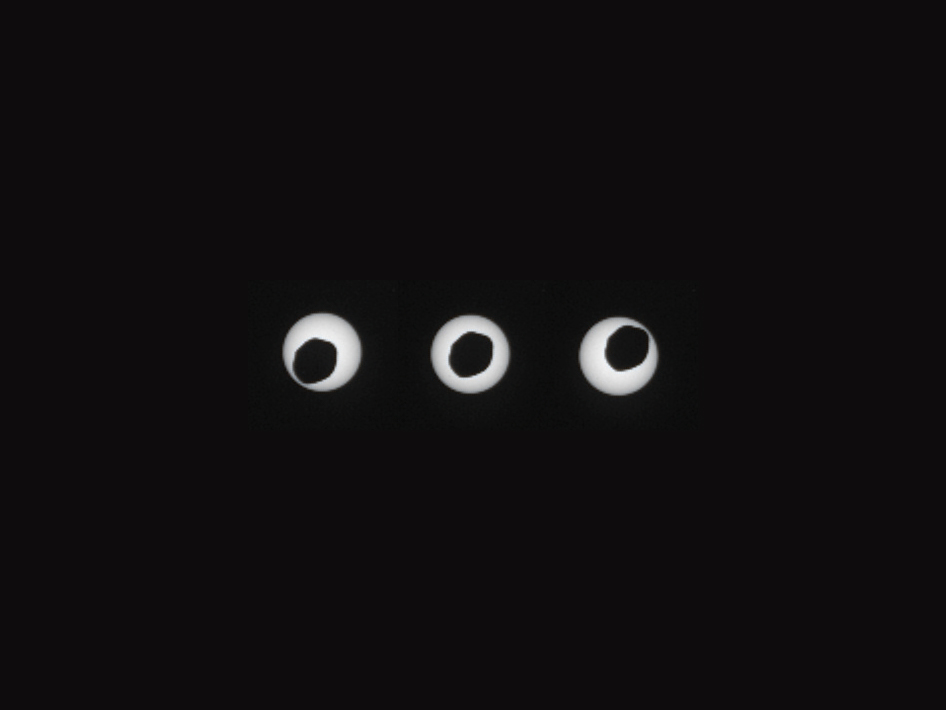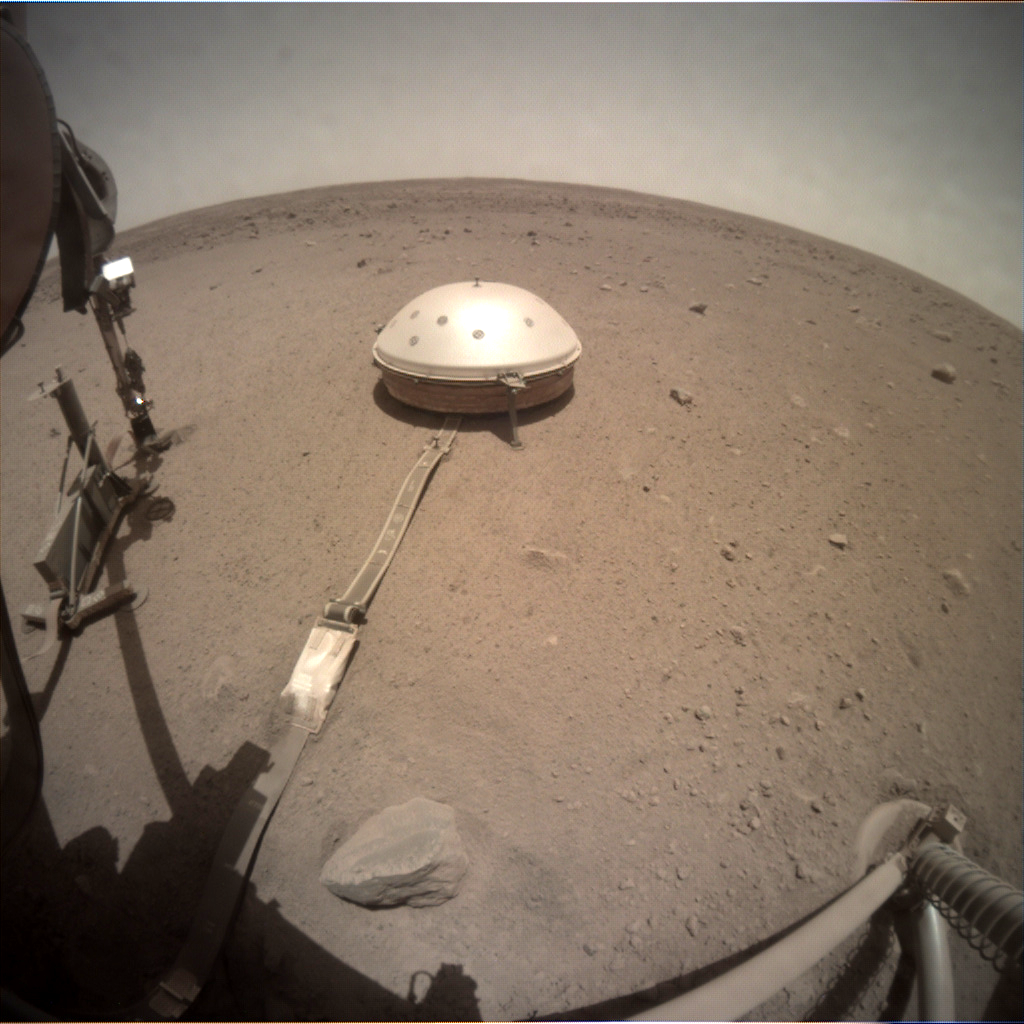Mars lander InSight picks up tiny ground tilt caused by Phobos moon transit

NASA's InSight Mars lander can detect a nearly imperceptible tilt caused by the planet's moon Phobos passing in front of the sun, scientists have realized.
And the measurements may help scientists pin down a number of eclectic facts about Mars and Phobos, particularly if InSight remains at work beyond its two-year primary mission, which runs out this fall. The new research is just the sort of science that wasn't on InSight's agenda but is an unexpected bonus discovered in the data.
"It's a completely lucky observation," Simon Stähler, lead author on the new research and a seismologist at ETH Zürich in Switzerland, told Space.com. "It could have been planned before, but we never did. But now we found it."
Related: Mars InSight in photos: NASA's mission to probe core of the Red Planet
Phobos is the larger of the two Martian moons and orbits closer to the Red Planet. Ever closer, in fact: Mars is pulling the moon in with its gravitational tug, and someday thousands of years from now Phobos will crash into its planet. But for now, Phobos simply loops around the world three times each Martian day.
That pace means lots of opportunities for Phobos to come between the sun and any given point on Mars, like the flatland called Elysium Planitia where InSight touched down in November 2018. But it was only early this year that scientists decided to see whether the lander had noticed anything strange during transits, which occur a handful of times a year, Stähler said.
"Unfortunately, at the time of the previous eclipses, nobody had thought about looking at it directly, so we let the data lay for almost a year," he said. But when he and his colleagues looked back at that data, they realized that the situation seemed complicated.
Get the Space.com Newsletter
Breaking space news, the latest updates on rocket launches, skywatching events and more!
"We found some not-quite-conclusive signals," he said. "But anyway, that gave us an idea on what to look at for the upcoming eclipse," which would occur on April 24. And this was a particularly promising transit: it would occur just before noon, so there would be lots of sunlight to block, and Phobos would cross the sun's disk more directly. All told, the scientists expected a 30% dip in light reaching the lander, six times the difference in dimming of some of the previous transits.
Related: Moons of Mars: Amazing photos of Phobos and Deimos
April 24 came and went on Mars and the researchers checked whether InSight's instruments had registered anything — and they had.
The lander's camera can't zoom enough to photograph a Phobos transit, but unsurprisingly, InSight's solar panels noticed the dip in sunlight reaching them. More strangely, the mission's seismometer and magnetometer had both noticed a difference as well.
The question was why.
Stähler said that he and his colleagues had hoped the transit might cause the same sorts of dramatic phenomena that solar eclipses can cause on Earth, like the massive atmospheric responses to the coolness of the sudden shadow, for example. Perhaps, even, the temperature drop triggered a low-pressure system that lifted the Martian surface a bit, explaining the seismometer's results.
But when the researchers looked more closely, that explanation turned out to be a bust. If a larger-scale atmospheric phenomenon were at play, the researchers should have caught its side effects during near misses, times when Phobos would have appeared to transit the sun as seen from a nearby location on Mars but only approached the sun from InSight's view.
Related: This picture is from Mars. It's probably not what you think.

The scientists solved the mystery thanks to a surprising parallel to seismometer data gathered at the Black Forest Observatory in Germany. There for the past 50 years, deep in an abandoned silver and cobalt mine, are a host of geosciences instruments, including seismometers that are particularly well-shielded from interference.
Stähler's colleague Rudolf Widmer-Schnidrig works with the observatory and, to him, InSight's data looked strangely familiar. He'd once left a light on near a seismometer, only to have an automatic timer switch the light off overnight — but a few feet away, the seismometer had registered a change.
"It saw a little tick, a little tilt, similar to what we saw on Mars," Stähler said. So Widmer-Schnidrig arranged to repeat the lightswitch trick deep in the mine, this time on purpose. And the signals did match, suggesting that particularly well-isolated sensitive seismometers, like InSight's and those in the Black Forest, can indeed detect a tiny tilt in the ground caused by light turning to dark and an accompanying cooling effect.
The tilt is smaller than small.
"If you imagine you had a 1-meter [3 feet] table and you lift one side of the table by one atomic diameter, that's sort of it," Stähler said of the tilt InSight's seismometer registered. "It's really a tiny, tiny signal." But it registered.
And the magnetometer's signal, the scientists eventually determined, reflected the sudden dip in power flowing through the solar panels during the transit.
At first, the realization was a letdown. "It was a bit of a disappointment, these results, because we had hoped that it would be some great planetary phenomenon that we're seeing here," Stähler said. "But both effects turned out to be quite local at the lander."
Despite the lack of a grand phenomenon behind the data, Stähler said that InSight's data about the transits will be quite useful. Because the magnetometer gathers data at very short intervals, InSight's data will allow scientists to time Phobos transits very precisely, pinning down the moon's location more accurately than ever before.
Phobos' location needs monitoring because of that slow creep in toward Mars, which is governed by the stretchiness of the planet's mantle. And InSight's transit observations aren't just the most precise yet, they also build on decades of measurements.
"We have the first observations of that from the Viking age and the latest ones are now InSight," Stähler said. "Basically, we have some almost 40 years of observation of how much Phobos is slowing down." And while these measurements won't necessarily move the needle on Phobos' doomsday, they could give scientists their best look at the mantle of Mars.
But despite the recent success, InSight's transit-watching days may end soon. The mission was originally budgeted to last only two years from its landing in November 2018 and NASA hasn't yet made a decision about extending it.
Stähler thinks a similar phenomenon may occur during transits and eclipses on other planetary bodies. It's not the sort of signal that seismometers on Earth seem able to pick up because eclipses here occur so gradually. But he sees potential in particular for Saturn's moon Titan — and NASA is including a seismometer on its Dragonfly mission to precisely that world.
"You can basically repeat the observation there in the end and can see how much the Titan ground deforms whenever Saturn blocks the sun there," Stähler said, although the moon's thick atmosphere will likely make the effect even smaller than on Mars. "Still, that's something to look forward to repeating there."
The research is described in a paper published Aug. 4 in the journal Geophysical Research Letters.
Email Meghan Bartels at mbartels@space.com or follow her on Twitter @meghanbartels. Follow us on Twitter @Spacedotcom and on Facebook.
Join our Space Forums to keep talking space on the latest missions, night sky and more! And if you have a news tip, correction or comment, let us know at: community@space.com.

Meghan is a senior writer at Space.com and has more than five years' experience as a science journalist based in New York City. She joined Space.com in July 2018, with previous writing published in outlets including Newsweek and Audubon. Meghan earned an MA in science journalism from New York University and a BA in classics from Georgetown University, and in her free time she enjoys reading and visiting museums. Follow her on Twitter at @meghanbartels.










